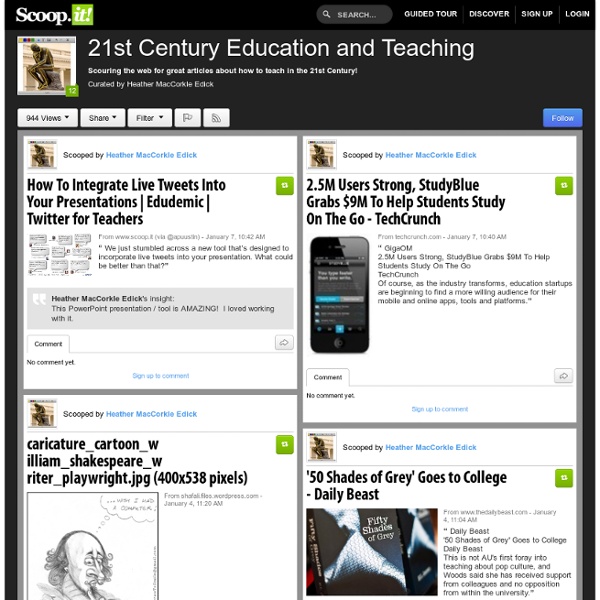



New Pedagogies For the Digital Age 15 Habits For Learning In The 21st Century 10.89K Views 0 Likes Defining 21st century skills is an editorial matter, but part of a larger, important conversation. How To Improve Learner Engagement With eLearning Software 5.05K Views 0 Likes Interaction and learner engagement have long been recognized for their critical role in the learning process. How A Tornado Inspired Innovation In Joplin, MO Schools 5.84K Views 0 Likes On May 22, 2011, at about dinnertime, an EF5 tornado ripped through Joplin, MO. The 21st Century Skills Teachers Should Have Technology advancements have touched every facet of life including education. This latter has been radically transformed and teachers who do not use social media and educational technology in their teaching no longer fit in the new system.That’s why every educator and teacher should reconsider certain values and principles . Today I am sharing with you two short videos that will hopefully change what some think about teaching. The following videos are among the top educative videos online . Watch this first one minute 40 seconds video to see the negative side of some teachers. Negative version of when i become a teacher So if you want to fit in the system and develop professionally then this is how to do it . watch this short video to learn more. positive version of when i become a teacher The 21st century teachers are characterized by certain holistic and student centered features , some of them are summarized below . The risk taker : The Collaborator : The model : The leader : The visionary :
3 Practices for 21st Century School Leaders In an interview with James Bellanca, education scholar Linda Darling-Hammond clearly delineates 3 practices administrators must engage in to bring our schools into the 21st century. (The interview can be found in the book 21st Century Skills: Rethinking How Students Learn.) "School leaders in the next decades need to engage in three practices that we haven't always seen as part of school administration. First is constructing time for teachers to work together on the development of curriculum and assessments. These 21st century educational leadership practices are clear. These three practices can have direct impact on teaching and learning in our schools, but they do require a willingness and courage to move beyond excuses.
21st Century Teacher We have heard alot about the 21st Century Learner. We know that they are:collaborativeadaptiveinformation, media and technology savvycommunicatorsimmediate and instantrequire instant gratificationcreators and adaptorBut what about the 21st Century Teacher, what are the characteristics we would expect to see in a 21st Century Educator. We know they are student centric, holistic, they are teaching about how to learn as much as teaching about the subject area. We know too, that they must be 21st Century learners as well. We expect our students to be life long learners. For their advice and feedback Sheryl Nussbaum-Beach, Rod Fee, Kim Cofino, Doug DeKock, David Truss
Assessment & Teaching of 21st-Century Skills Learning happens everywhere, and so does this challenge | Reinventing School August 2nd, 2011 | Brendan | Design Thinking , Reinventing Class , Reinventing Education , Reinventing School | challenge , community , diversity , education , friends , participation , social media | I want to ensure that the entire community feels welcome and able to participate in the Reinventing School Challenge . While students and educators are most likely to be attracted to the challenge, teams can participate from many other organisations or groups. Some of you educators may feel that the current state of affairs in your school setting makes it too difficult to facilitate your students in the challenge at this time.You may be a passionate parent or youth leader who feels you want to change the way we educate our young people and want to make a difference. No problem. One of my life missions is to encourage life-long learning, promote alternative learning environments and inspire people to live their dreams. Tell the world the challenge is here - Get involved and shout it out!
The Kit | Reinventing School The Kit March 26th, 2011 | Brendan | | --> What on earth is Design Thinking? Why Design Thinking? Design thinking is a methodology for practical, creative resolution of problems or issues that looks for an improved future result. Read all about how the Design Thinking process drives the challenge here. This is a collection of curriculum created by the K-12 Lab at the Stanford design school and teachers who are using design thinking in their schools. The kit is split into sections for easy download. This work is licensed under a Creative Commons Attribution-NonCommercial-ShareAlike 3.0 Unported License . Key documents Design Thinking for Educators toolkit (PDF 20.4 MB) An Educator’s Guide to Design Thinking (PDF 4.8 MB) Bootcamp bootleg (PDF 3.6MB) d.school mindsets (PDF 223 KB Supporting resources and tools Here are some great tools and resources .
Homework: It fails our students and undermines American education SmartBlogs Students often ask me why I don’t assign homework. “I don’t believe in it,” I quickly respond. “It doesn’t tell me what you’re learning.” They forge ahead with furrowed eyebrows. “Then why do all of our other teachers assign homework?” Although I typically leave that one alone, my experience tells me that the answer isn’t at all elusive. This practice of assigning homework, simply because it’ something that’s always been done, is not only absurd and outdated, it is undermining effective 21st-century teaching and learning. A few summers ago, I looked in the mirror and said, “Enough is enough; something has to change, and it has to start with my approach to teaching and learning.” So the homework stopped. Are you ready to throw out homework? Mark Barnes is a 20-year classroom teacher and adjunct professor at two Ohio colleges.